Key:maxweight
| Description |
|---|
| permissible maximum actual weight. |
| Group: Restrictions |
| Used on these elements |
| Useful combination |
|
| See also |
| Status: de facto |
| Tools for this tag |
|
Legal access restriction for vehicles or passengers that exceed the specified actual weight, especially useful on bridge segments (tagged with bridge=*). Metric tonnes are a default unit, other units must be explicitly tagged. Typical usage is to add this tag to highway=* lines where maxweight limit applies.
Note: for maximum gross weight see maxweightrating=*
Vehicle weight
A number of navigable structures that are mapped as ways or areas may be tagged with a vehicle weight restriction, such as:
If a unit is not specified, the value is assumed to be in tonnes (British English, 'metric tons' in American English). You must explicitly specify the unit if it is not in metric tonnes. See page Units for possible units and format. If the restriction applies only to some classes of vehicles, way direction, lanes, or time condition, follow maxspeed#Extended tagging.
In cases of some objects, for example bridges it may be desirable to tag that place was surveyed and no max weight sign was found. Tag used for this include maxweight=unsigned and maxweight:signed=no. There is also maxweight=none, but it is misleading as there are also default max weight of vehicles set by law, it is unlikely to find place where one is actually allowed to drive vehicles without any weight limits.
Basic example
A small bridge with limited weight
Tags on a road segment representing road on a bridge:
Regional variations
Vienna Convention
In the Vienna Convention on Road Traffic (Nov 8, 1968), this property relates to Chapter 1, Art. 1 (y) Laden mass means the actual mass of the vehicle as loaded, with the crew and passengers on board;
United States
In most of the United States, weight restrictions are expressed in short tons (abbreviated as "tons", "T", or "t"), which should be tagged as maxweight=### st, and sometimes in pounds (abbreviated as "lbs"), which should be tagged as maxweight=### lbs, but never as metric tons. In Texas, the weight given on signs is always expressed in pounds. (In the past, many mappers converted short tons to pounds and used the lbs suffix even when the signs were expressed in short tons. More recently, the st suffix was introduced for short tons, so that mappers don't have to do arithmetic.[1])
Besides the prima facie restrictions on the signs below, each state has a number of statutory tolerances and exemptions for specific types of cargo, often seasonally.[2] Mappers should focus on the restrictions on the signs and ignore statutory exceptions.
Examples by sign
with signs around the world:
Argentina:
maxweight=4Armenia:
maxweight=7Australia:
maxweight=*Belgium:
maxweight=5.5
(use dot as decimal separator)Brazil:
maxweight=10Finland:
maxweight=12Georgia:
maxweight=7Germany:
maxweight=5.5
(use dot as decimal separator)Guernsey:
maxweight=30 cwtGreece:
maxweight=5Hong Kong:
maxweight=10Ireland:
maxweight=10Israel:
maxweight=6Mexico:
maxweight=10New Zealand:
maxweight=44 (Class I is a weight standard, the maximum of which is 44 tonnes)Philippines:
maxweight:hgv=17
maxweight:hgv:conditional=17 @ (axles=2); 27 @ (axles>=3); 38 @ (axles>=5)Saudi Arabia:
maxweight=*Singapore:
maxweight=26South Korea:
maxweight=5.5Switzerland:
maxweight=5.5
(use dot as decimal separator)Taiwan:
maxweight=5.5Thailand:
maxweight=10
Canada
Ontario:
maxweight=10Ontario:
maxweight:hgv=*
maxweight:hgv_articulated=*
maxweight:hgv:conditional=* @ (trailer)Ontario:
maxweight=5
maxweight:conditional=none @ (transponder)Quebec:
maxweight:hgv=*
maxweight:hgv:conditional=none @ (delivery)Quebec:
maxweight=*Saskatchewan:
maxweight=10
United States
Federal, state, county, and municipal highway departments post a wide variety of sign designs that indicate a number of different formulae for computing weight restrictions. The most common sign designs are displayed in the following gallery, most of them from state standards.
United States:
maxweight=10 st
(specify unit as short tons)United States:
maxweight=10 st
maxaxleload=2 st
(specify unit as short tons)United States:
maxweight=8 st[3]
maxweight:hgv_articulated=12 st
maxweight:hgv:conditional=16 st @ (trailer)
(specify unit as short tons)Delaware:
maxweight=3 st
maxweight:hgv:conditional=20 st @ (axles=3); 28 st @ (trailer)
maxweight:hgv_articulated=27 stIllinois:
maxweight=17 st
maxweight:hgv:conditional=21 st @ (axle=3 and trailer); 21 st @ (axle=4 and trailer); 23 st @ (axle>=5 and trailer)
maxweight:hgv:conditional=21 st @ (axle=3 or axle=4); 23 st @ (axle>=5)
(specify unit as short tons)Illinois:
maxweight:hgv=22 st
maxweight:hgv:conditional=29 st @ (axle=3 and trailer); 29 st @ (axle=4 and trailer); 36 st @ (axle>=5 and trailer)
maxweight:hgv_articulated:conditional=29 st @ (axle=3 or axle=4); 36 st @ (axle>=5)
(specify unit as short tons)Illinois:
maxweight:hgv=16 st
maxweight:hgv:conditional=20 st @ (trailer)
maxweight:hgv_articulated=20 st
(specify unit as short tons)Illinois:
maxweight:conditional=5 st @ (Jan 05-Apr 05)
(specify unit as short tons)Illinois:
maxweight=40 st
maxaxleload=10 st
(specify unit as short tons)Kentucky:
maxweight=25 st
maxweight:hgv:conditional=25 st @ (axles=2); 28 st @ (axles=3); 34 st @ (axles=4 or axles=5); 35 st @ (axles=6); 38 st @ (axles>=7)
maxweight:hgv_articulated=44 st
(specify unit as short tons)Ohio:
maxweight=10 st
maxweight:hgv:conditional=10 st @ (axles=2); 14 st @ (axles=3); 18 st @ (axles=4); 22 st @ (axles=5); 24 st @ (axles>=6)
maxweight:hgv_articulated=40 st
(specify unit as short tons)Ohio:
maxweight:emergency=25 st
maxweight:emergency:conditional=25 st @ (axles=2); 40 st @ (axles>=3)
(specify unit as short tons)Ohio:
maxweight:conditional=12 st @ (Feb 1-May 15)
maxweight:hgv:conditional=12 st @ (Feb 1-May 15 AND axles=2); 36800 lbs @ (Feb 1-May 15 AND axles=3); 43200 lbs @ (Feb 1-May 15 AND axles=4); 49600 lbs @ (Feb 1-May 15 AND axles=5); 55600 lbs @ (Feb 1-May 15 AND axles=6); 31 st @ (Feb 1-May 15 AND axles>=7)
maxweight:hgv_articulated:conditional=32 st @ (Feb 1-May 15)
(80% of legal load limits for configurations 2F1, 3F1, 4F1/SU4, SU5, SU6, SU7, and 5C1, respectively[5][6][7])Oregon:
maxweight=25 st
maxweight:hgv_articulated=40 st
maxweight:hgv:conditional=27 st @ (axles=4); 31 st @ (axles=5); 36 st @ (axles>=6); 40 st @ (trailer)
(specify unit as short tons)Puerto Rico:
maxweight=10 st
(specify unit as short tons)Puerto Rico:
maxweight=8 st[3]
maxweight:hgv_articulated=12 st
maxweight:hgv:conditional=16 st @ (trailer)
(specify unit as short tons)Puerto Rico:
maxweight:emergency=* st (total)
maxaxleload:emergency=* st (sencillo)
maxbogieweight:emergency=* st (doble)Puerto Rico:
maxweight=* st (total)
maxaxleload=* st (sencillo)
maxbogieweight=* st (doble)Texas:
maxweight=58420 lbs
(specify unit as pounds)Texas:
maxweight=23000 lbs
maxaxleload=10000 lbs
maxbogieweight=10000 lbs
(specify unit as pounds)Texas:
maxweight=60000 lbs
maxbogieweight=28000 lbs
(specify unit as pounds)Texas:
maxweight=25100 lbs
maxweight:hgv:conditional=38200 lbs @ (trailer)
maxweight:hgv_articulated=38200 lbs
maxaxleload=10400 lbs
maxbogieweight=16200 lbs
(specify unit as pounds)
Lookalikes
Caution, pitfall! The signs below are not weight restrictions, but rather restrictions for goods vehicles with a maximum allowed weight above the depicted value, or max weight per axle not per vehicle.
See more examples at Key:maxweightrating and Key:maxaxleload pages.
Germany:
maxweightrating:hgv=7.5Ireland:
overtaking:hgv:conditional=no @ (weight>3)Ireland:
maxweightrating:hgv=3Singapore:
maxunladenweight=2500 kgUnited Kingdom:
maxweightrating:hgv=7.5United States:
maxaxleload=5 st
(specify unit as short tons)United States:
maxunladenweight:hgv=7000 lbs[8]United States (Ohio):
maxaxleload:emergency=12 st
maxbogieweight:emergency=26 st
(specify unit as short tons)United States (Texas):
maxaxleload=17500 lbs
maxbogieweight=17500 lbsUnited States (Texas):
maxbogieweight=28000 lbsUnited States (Texas):
maxaxleload=25000 lbs
maxaxleload:conditional=8000 lbs @ (bogie)United States (Texas):
maxaxleload=10400 lbs
maxbogieweight=16200 lbs
Passenger weight
This key is also used to indicate a maximum passenger weight on some conveyances that may be mapped as nodes, ways, or areas, such as:
These restrictions are usually expressed in human-scale units, such as kilograms (kg) and pounds (lbs). You must explicitly specify the unit to prevent data consumers from misinterpreting a passenger weight restriction as a tonnage.
References
- ↑ https://osmus.slack.com/archives/C029HV951/p1561048586262200
- ↑ “Compilation of Existing State Truck Size and Weight Limit Laws”. Federal Highway Administration. February 1, 2017. Retrieved July 6, 2019.
- ↑ 3.0 3.1 The NCUTCD has recommended that a future MUTCD standard "Clarify that the single-unit truck silhouette shown in the R12-5 sign shall apply to all single unit vehicles, regardless of the number of axles or shape of vehicle." [1] As of 2019, this recommendation about the
 symbol has not yet been incorporated into the MUTCD or any state MUTCD, but see the meeting minutes for several state variations on MUTCD R12-5 that express clearer limits than the current national standard.
symbol has not yet been incorporated into the MUTCD or any state MUTCD, but see the meeting minutes for several state variations on MUTCD R12-5 that express clearer limits than the current national standard.
- ↑ http://www.calhouncountyroads.com/about/services/bridge-data/weight-limit-signs/
- ↑ “Manual of Bridge Inspection” (PDF). Ohio Department of Transportation. 2014. p. 40.
- ↑ Waheed, Amjad (August 18, 2016). “Special Hauling Vehicles (SHV) Load Rating Update” (PDF). County Engineers Association of Ohio. p. 15.
- ↑ “Implementation of Special Hauling Vehicles in the ODOT Load Rating Process” (PDF). County Engineers Association of Ohio. March 10, 2020. pp. 7–8.
- ↑ proposed on tagging mailing list https://lists.openstreetmap.org/pipermail/tagging/2019-July/046374.html as maxemptyweight=*, later changed proposed key fo reasons listed in https://lists.openstreetmap.org/pipermail/tagging/2019-July/046477.html
See also
- maxweightrating=* - for restrictions that are not based on the actual weight but on the gross maximal mass rating of the vehicle. (Legal access restriction for vehicles with a maximum permitted mass above the specified mass in metric tonnes).
- maxaxleload=* - The legal maximum axleload in metric tonnes.
- access=* - legal accessibility according to vehicle class or kind of use
- amenity=weighbridge - A large weight scale to weigh vehicles and goods
- Conditional restrictions - restrictions depending on a condition.
- Proposed_features/gross_weight - Proposal to express limitations/restrictions of the acutal weight, weight rating of vehicles and combinations (trailers) and to express conditional restrictions based on weight properties
External links
- "Vehicle Types", Traffic Monitoring Guide, U.S. Federal Highway Administration Office of Highway Policy Information – helpful for interpreting truck symbols on U.S. signs



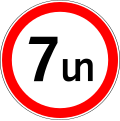











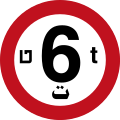
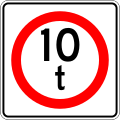



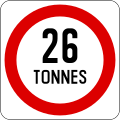


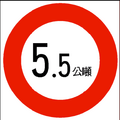
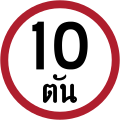









![United States: maxweight=8 st[3] maxweight:hgv_articulated=12 st maxweight:hgv:conditional=16 st @ (trailer) (specify unit as short tons)](https://upload.wikimedia.org/wikipedia/commons/thumb/2/28/MUTCD_R12-5.svg/80px-MUTCD_R12-5.svg.png)

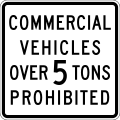







![Michigan: maxweight:hgv_articulated=72 st maxweight:roadtrain=none (specify unit as short tons; "NA" stands for "not applicable"[4])](/w/images/thumb/8/8a/LSouthWestOf25andaHalf.jpg/135px-LSouthWestOf25andaHalf.jpg)


![Ohio: maxweight:conditional=12 st @ (Feb 1-May 15) maxweight:hgv:conditional=12 st @ (Feb 1-May 15 AND axles=2); 36800 lbs @ (Feb 1-May 15 AND axles=3); 43200 lbs @ (Feb 1-May 15 AND axles=4); 49600 lbs @ (Feb 1-May 15 AND axles=5); 55600 lbs @ (Feb 1-May 15 AND axles=6); 31 st @ (Feb 1-May 15 AND axles>=7) maxweight:hgv_articulated:conditional=32 st @ (Feb 1-May 15) (80% of legal load limits for configurations 2F1, 3F1, 4F1/SU4, SU5, SU6, SU7, and 5C1, respectively[5][6][7])](https://upload.wikimedia.org/wikipedia/commons/thumb/6/67/MUTCD-OH_R12-H17.svg/120px-MUTCD-OH_R12-H17.svg.png)


![Puerto Rico: maxweight=8 st[3] maxweight:hgv_articulated=12 st maxweight:hgv:conditional=16 st @ (trailer) (specify unit as short tons)](https://upload.wikimedia.org/wikipedia/commons/thumb/e/e3/MUTCD-PR_R12-5.svg/96px-MUTCD-PR_R12-5.svg.png)

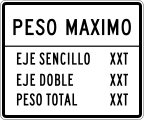






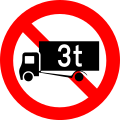



![United States: maxunladenweight:hgv=7000 lbs[8]](https://upload.wikimedia.org/wikipedia/commons/thumb/2/23/MUTCD_R12-3.svg/80px-MUTCD_R12-3.svg.png)




